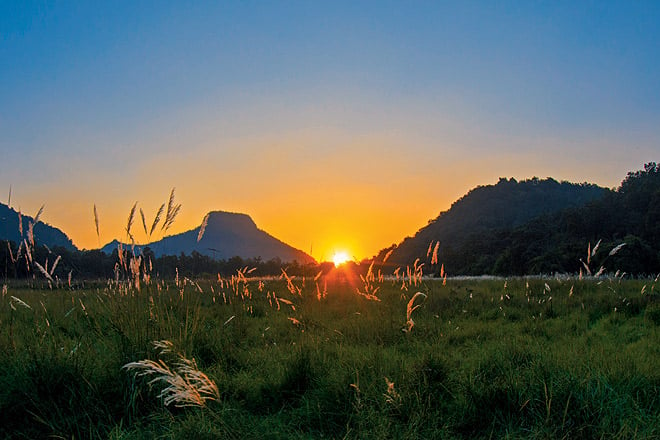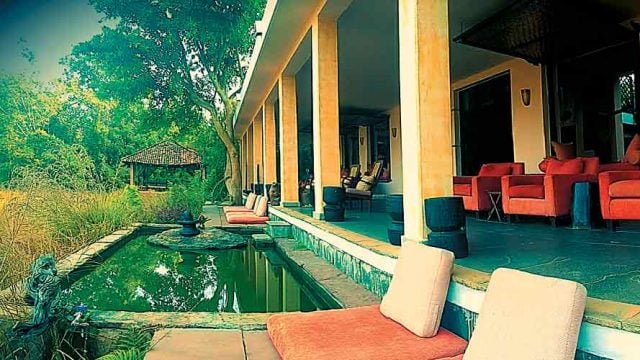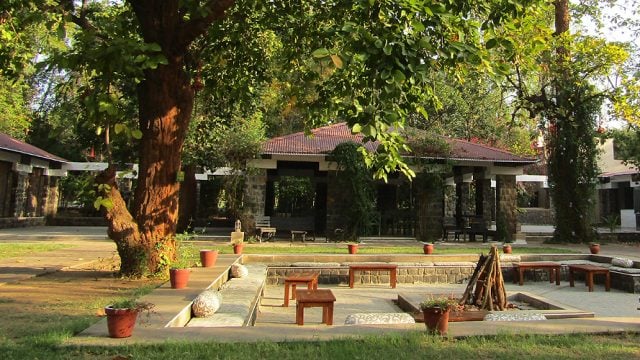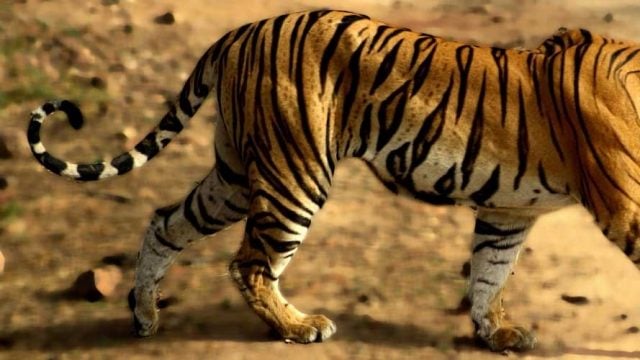Fresh pugmarks, the impressions large and slightly splayed, followed by small, neat ones: a tiger and its
So what if it isn’t the most coveted territory for safaris? So what if we’ve missed out on Tala, the premium zone, booked months ahead by visitors from abroad? Venturing into the jungle at that unearthly hour has its own rewards: a full moon setting in a paling sky to our right, a yolk-orange sun rising simultaneously to the left, that eerie, breathless stillness in the air… and fresh pugmarks.
Hours later, the charm is beginning to pall — despite the picnic breakfast served in a clearing to boost our waning enthusiasm. We’ve roamed up and down assigned routes, flanked by miles of bamboo groves interspersed with open expanses of tall, feathery elephant and kans grass and stared endlessly at herds of grazing deer. I’ve even had to keep my spirits up by imagining things — a sloth bear in place of a shadow, a poisonous serpent which is actually a creeper.
It doesn’t help that other safari jeeps keep crossing our path, the crestfallen expressions of their occupants mirroring our own. The exchanges between the guides are terse:
“Kuch dekha?”
“Nah!”
The tigers have evidently done a Greta Garbo. And the alarm calls — a sonorous “bhonk” from a sambar, a flirty “pok-pokpok” from a chital, a shrieking “paonpaon-paon-paon” from a panic-stricken peacock in flight — are all red herrings.
“There have been several recent sightings of tigers in Magdhi,” consoles our resort’s naturalist Ravi at lunch, trying to whet our enthusiasm for the afternoon safari in the same zone.
Liar! Our post-lunch drive yields nothing but a false rumour of tigers growling in a wide field of swaying grass at sundown.
Dinner would have been a melancholy affair but for our resort manager, Mr Singh, who knows that a hot towel and a commiserating smile aren’t consolation enough for guests returning from fruitless safaris with cheated expressions. And so he spins tales — of a resident snake that had dropped from the ceiling onto the resort’s dining table once, where a group of English tourists was seated, and had proceeded to shimmy its way up and down the table, setting the cutlery singing to the accompaniment of very Brit exclamations of horror; of an elephant safari ambushed by a crotchety tiger, that had resulted in Jumbo shying away, his howdah tilting and one of its occupants, an obese teenager, sliding off the rear and hanging onto the pachyderm’s tail for dear life. Jungle lore, befitting Madhya Pradesh’s mecca for lovers of striped cats.
“But it all happened,” Mr. Singh clarifies, “before elephant safaris were put on hold; before a Supreme Court order in 2012 restricted public access to a mere 20 per cent of the reserve’s core area; before the Forest Department divided it further into three distinct zones — Tala, Magdhi and Khitauli — and confined each safari to a demarcated one; before jeep excursions to the site of the Bandhavgarh Fort — the Maharaja of Rewa’s former hunting lodge on the summit of a hill in the Tala zone — were banned and the Vishnu temple near it declared out of bounds.”
“Before” was evidently a magical era — far removed from our own depressing reality.
Naturally, we’re expecting zilch from the following morning’s safari in Khitauli. It’s essentially leopard country, a terrain abundant in stream beds and water bodies, attracting a vibrant bird life. Midnight blue racket-tailed drongos trail feathered trains worthy of a redcarpet appearance, and a woodpecker flaunts its drilling prowess. Further on, a gang of langurs blissfully feasts on delicacies — termites picked off a rotting tree trunk. There’s a tense moment as their scout, perched on a treetop, begins issuing alarm calls — uncannily like an old man’s cough.
“Tendua,” whispers Jai Prakash, our assigned guide.
But the leopard, characteristically, remains in purdah.
At lunchtime, Mr Singh approaches us with an offer to join a safari that a fellow resort guest has managed to wangle for that afternoon in Tala.
Tala! We’re off in a flash.
Tala isn’t lusted after for nothing; it contains one of the most beautiful forests I’ve seen, all rock and hill and dense vegetation. It also boasts a modest shrine to Siddhi Baba, patron protector of the forest.
“Just one tiger, Baba!” I pray.
Looking tiny atop a hill, the forbidden Bandhavgarh Fort and Vishnu temple are bathed in the waning light of late afternoon. Noting our wistful expressions, Ravi drives us up a rough, winding track to another sacred site — Shesh Shaiya, an eerily beautiful place, reminiscent of Angkor Wat. Dominating it is a colossal, reclining, 10th-century image of Vishnu hewn out of the rock face. A seven-hooded rock serpent hovers protectively over it. To the idol’s left stands a large shivling, also carved out of rock. The small Brahma statue to its right has apparently been destroyed by time.
The surrounding vegetation is dense, the silence daunting. Wood spiders perch in the centre of elaborate webs, waiting for prey.
“Just one little tiger!” I entreat the deities, glancing at my watch. We’re nearing park-closing time and I feel like Cinderella, moments before midnight.
With just 45 minutes in hand, Ravi decides to drive a little further down a track than he should, before turning the jeep around. And that’s when I spot it in the shade of a bamboo grove: a seated tiger looking our way, the markings on its face distinct.
“Weird! That looks just like a tiger!”
I ponder silently, putting it down to my wishful imagination.
“There!” our guide exclaims hoarsely, springing up from his seat and pointing in the same direction, “there he is!”
The startled cat leaps to its feet and slinks off to lower ground in a bid to conceal itself. Unaware that its undulating striped back is clearly visible, it crawls away on its belly, playing hide and seek as it moves deeper into the grove. Once inside, believing it’s out of sight, it stands awkwardly and peers out at us, a dark silhouette in the failing light, looking like a dazed tabby that has just had the fright of its life.
We burst out laughing. Mortified, the tiger vanishes into the tall grass of a sloping field behind the grove.
Beyond it lies Chuha village — ‘our’ tiger’s favourite haunt, as Ravi informs us later by email. Except that it’s a sub-adult tigress, rarely seen, and the only surviving offspring from a litter of three. A scaredy-cat in the true sense, fit to give the entire feline species a bad name. But I couldn’t have asked the gods for more. Beggars can’t be choosers in these less-than-magical times.
The information
Getting there: The nearest airport to Bandhavgarhis Jabalpur. Airfaresfluctuate greatly, depending onseason. Bandhavgarh National Park is approximately a 3.5-hourdrive from Jabalpur.
Where to stay: For a top-end experience, try the Mahua Kothi (from Rs 18,500 plus taxes per person per night on a twin-sharing basis for the Full Jungle Plan that includes two safaris a day; tajhotels.com).There’s a Limited Jungle Plan available as well. For a good mid-range option, you could try the Bandhavgarh Jungle Lodge (3D/2N doubles package Rs 15,650, taxes and safari fees extra; [email protected]).This offer is valid only until June 30, 2015.
Safaris: There are two daily safaris in Bandhavgarh, of which the 6.30am–10.30am one in Tala zone is recommended. Bookings should be done well in advance. Travel agents can organise entry permit, vehicle, driver and guide via your chosen hotel.
Safari fees vary. Bandhavgarh Jungle Lodge charges approximately Rs 4,500 per safari (subject to change) in the Magdhi and Khitauli zones and Rs 5,500 in the Tala zone. A valid photo ID is required for booking a safari and for entering the wildlife reserve. The best time to visit is from October to May, though visibility is poor in January. The park remains closed from July 1 to October 14.
Madhya Pradesh
safari
tiger sighting





